This was the featured car at RM Auctions’ Monterey Sports Car Auction, August 16-17, 2002 and sold for $6,490,000 ($5,900,000 hammer). Reproductions of the catalog pages are used with permission. © 2002 R.S. Carey and the auction company.
Research for this description uncovered an apparently previously unremarked parallel between the history and success of the Scuderia Ferrari Testa Rossas and the driving talents of Phil Hill and Olivier Gendebien. Click here to jump to
that section of the description.
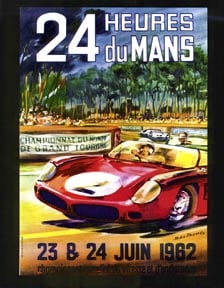
The 1962 Le Mans-winning, Phil Hill/Olivier Gendebien
Ferrari 330 TRI/LM Testa Rossa
Coachwork by Fantuzzi
Chassis No. 0808
Engine No. 0808
390hp 3,967cc single overhead camshaft V12 engine, 5-speed manual [gearbox], 4-wheel disc brakes. Wheelbase 2,420mm (95.3″).
The first car in a series is good. But the last car is best. It is inevitably refined, improved and developed. Its weaknesses have been addressed and its
strengths have been enhanced.
Technical sophistication is important, too, particularly if it represents a unique and successful configuration. A real, documented and important history makes it better, more so if it includes a long roster of the best drivers. But most important of all is success. Commercial success is good, but success in
competition is better and the overall winner of the 24 Heures du Mans is the best of all.
The expression of all these attributes is the 1962 Ferrari 330 TRI/LM, chassis number 0808, offered here. The only 4-liter Testa Rossa built, it also is the last Testa Rossa built by Ferrari. Driven by the incomparable endurance racing pairing of Phil Hill and Olivier Gendebien, it is the last front-engined car to capture the overall victory at Le Mans, the Hill/Gendebien team’s epic third Le Mans win. Its provenance is impeccably documented. It is incomparable and absolutely unique.
It also is two cars in one, having started life as the Scuderia SEFAC Ferrari 250 TRI60/61 Spider s/n 0780 TR in 1960, a Ferrari that would be highly sought for its own technical attributes, history and racing successes. But 0780 TR was utilized by Ferrari at the end of the 1961 season to form the basis for 0808, merging their histories of races and drivers into one, literally building success upon success.
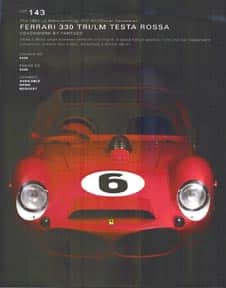

The Ferrari Testa Rossa itself is the most famous series of sports-racing cars ever built. This is the ultimate Ferrari Testa Rossa.
The history of the Testa Rossa series began six years earlier, in 1956, also with a victory. A 4-cylinder customer sports-racer, it met the demand from private entrants for a 2-liter Ferrari consistently capable of defeating the Maseratis. Its engine and suspension were based upon the successful Type 500 Formula 2 cars of 1952-1953, an Aurelio Lampredi-designed light alloy dual overhead camshaft 4-cylinder with dual ignition and a pair of Weber side draft carbs in a twin main-tube frame with coil spring independent front suspension. A solid rear axle with coil springs and twin trailing arms replaced the Type 500’s deDion system in the 500 Testa Rossa. Scuderia Ferrari entered three 500 Testa Rossas in the Supercortemaggiore race at Monza on June 24, 1956. Peter Collins and Mike Hawthorn drove the winning car while Fangio/Castellotti took third. Alfonso de Portago and Olivier Gendebien finished fourth.
The Testa Rossa’s Evolution
Spectator and participant deaths in the 1954 Carrera Panamericana Mexico were followed by Levegh’s disaster at Le Mans in 1955 and capped by De Portago’s 1957 Mille Miglia accident. The popular media was transported into paroxysms of righteousness, blaming speed rather than crowd control and clamoring for changes in racing regulations rather than taking the race organizers to task for their indifference to spectator safety. The end of unlimited displacement racing for the World Sports Car Championship was a certainty. The only question was the form it would take.
Ferrari threw his not-inconsiderable influence behind a 3-liter displacement limit, knowing it would not only satisfy the media whiners but also support an ever-growing market among private entrants in the United States. The Ferrari arsenal included three distinct engine families from which to choose, the 750
Monza 4-cylinder, the 4-cam V12 used in the 315S and 335S and the 250 GT V12, recently improved with coil valve springs, 4-stud heads and individual intake ports. Ferrari’s choice was the Colombo V12 which, massaged by ten years’ effort from Lampredi, Jano, Bellentani and anonymous other talents within
Ferrari’s organization, offered an astute balance among the competing considerations of reliability, potential and power.
The unlikely evolution of the Testa Rossa designation from the 2-liter fours to the 3-liter V12s seems to derive from the second prototype, s/n 0704, originally built as a 500 TRC. It was bodied with Scaglietti’s innovative “pontoon-fendered” coachwork (in an effort to compensate for Ferrari’s
reliance upon drum brakes with increased air flow.) Although 0704 did not finish in its first appearance at Le Mans in 1957, it finished 4th in
Venezuela driven by Maurice Trintignant and Olivier Gendebien and started the 1958 season with wins in Argentina and Sebring and a 4th in the Targa Florio driven by Phil Hill and Peter Collins followed by 2nd at the Nürburgring (Hawthorn/Collins).


Even at the prototype stage the synergy among Phil Hill, Olivier Gendebien and the Ferrari Testa Rossa was emerging.
Phil Hill and Olivier Gendebien
Phil Hill and Olivier Gendebien were an unusual combination. Yet, like many successful pairings, their disparate personalities and backgrounds merged to
make the first truly successful team of endurance racers in history.
Gendebien was born to privilege, the son of a Belgian diplomat. He spent WWII as a paratrooper, then went to the Congo as a forester, returning to Europe to drive in rallies with Charles Fraikin. Gendebien’s talent was recognized by Ferrari and he became a contracted driver for SEFAC Ferrari, finishing fifth in his first GP race in Argentina in 1956. But his success would come in GT and sports cars where his string of victories driving the 250 GT in the Tour de France earned the model its name. Gendebien’s third place in the final Mille Miglia in 1957 is the stuff of legends. Driving a 250 GT Tour de France he finished barely eight minutes behind Piero Taruffi in the winning Ferrari 335 S sports-racer. Aristocratic and refined, Olivier Gendebien had two great
attributes beyond his unruffled and secure demeanor: superb car control and an innate sensitivity to his cars’ limits.
Hill was the son of the U.S. Postmaster in Santa Monica, California. It’s trite, but accurate, that Hill was brought up in Southern California’s car-crazy
environment and not inaccurate to picture him at an early age in chinos or Levis and a tee-shirt. He abandoned college in 1949 to attend an SU carburetor
training course in England and returned to California with an XK 120 Jaguar which he raced successfully in 1950. Picked up by Allen Guiberson, one of the
“angels” in Southern California road racing, where his performances in Ferraris, not least his epic 1,908-mile duel with Umberto Maglioli in the 1954
Carrera Panamericana Mexico where Hill with co-driver Richie Ginther finished an impressive second driving an outdated Ferrari 375 MM, made him a standout
performer among a generation of famous drivers. Luigi Chinetti persuaded Ferrari to pair Hill with Gendebien at Argentina in January 1956. They finished second overall. Shortly thereafter Hill moved to Modena as a Ferrari factory team driver. Mechanically intuitive and voluble, Phil Hill had two great attributes beyond his enthusiasm and experience building, tuning and maintaining race cars: superb car control and an innate sensitivity to his cars’ limits.
The team was in place. Only the car(s) remained.
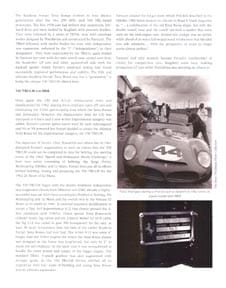
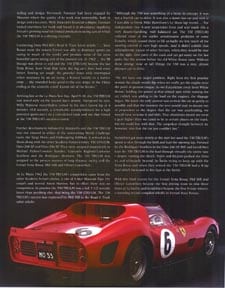
The Testa Rossa and Le Mans
Ferrari introduced the 250 Testa Rossa at Modena on November 22, 1957 but it was anything but “definitive”, the factory reserving righthand-drive and
deDion rear suspension chassis for its use. Clients’ cars would be lefthand-drive and use a solid rear axle.
The Testa Rossa was already a racing success when it was introduced and it went on to a string of victories that are simply too numerous to describe in anything less than a book, of which several have been written. Even the racing history of the single Testa Rossa offered here, 0780/0808, takes up a voluminous sidebar. But it was at Le Mans where the Testa Rossa established its reputation. Le Mans is … well, it is “the race.”
Starting at 4 PM, Le Mans races through the shortest weekend night of the year, at a latitude where the Midnight Sun is not an abstraction. It frequently drenches its competitors with rain. Sunrise comes early, only to remind competitors that the race is barely half over. Scion of the original French Grand Prix, the mother of all road races, it is the last great road race on closed public roads. Scuderia Ferrari built its best Testa Rossas for Le Mans, winning in 1958 (Hill/Gendebien, s/n 0728), 1960 (Frere/Gendebien, TR 59/60 s/n 0772/0774), 1961 (Hill/Gendebien, TRI61 s/n 0794) and 1962 (Hill/Gendebien with 330 TRI/LM s/n 0808).
The racing record of Scuderia Ferrari’s Testa Rossas is astounding. Forty-nine cars started twenty races. Thirty of them finished (61%), winning eleven races (55%) and capturing the Sports Car Championship in three of the four years it was contested. Customer cars won numerous national championships. A Scuderia Ferrari Testa Rossa that finished a race during the four years from 1958 through 1961 never finished lower than fifth. It is a history of epic automobiles and epic drives by legendary drivers, all leading up to the Testa Rossa’s ultimate Le Mans victory in 1962.
The Scuderia Ferrari Testa Rossas evolved in four distinct generations after the two 290 MM- and 500 TRC-based prototypes. The first 1958 cars had deDion rear suspension, left-hand drive and were bodied by Scaglietti with pontoon fenders. They were followed by a series of TR59s, now with envelope bodies designed by Pininfarina and constructed by Fantuzzi. The TRI60 followed, with similar bodies but now with independent rear suspension, indicated by the “I” (“Independente”) in their designation . They were superseded by the TRI61s, again bodied by Fantuzzi but now with the twin nostril nose carried over from the Scuderia’s GP cars and taller, squared-off tails with the ducktail spoiler which Ferrari’s empirical testing had found successfully improved performance and stability. The fifth and ultimate Scuderia Ferrari Testa Rossa was not a “generation,” it being the unique 330 TRI/LM offered here.
330 TRI/LM s/n 0808

Once again the CSI and A.C.O. restructured rules and classifications for 1962, placing their emphasis upon GT cars and eliminating the 3-liter sports-racing class which the Testa Rossas had dominated. However, the displacement limit for GTs was increased to 4 liters and a new 4-liter Experimental category was added. Ferrari’s current sports-racers were by now mid-engined and V6 or V8 powered but Ferrari decided to create the ultimate Testa Rossa for the Experimental category, the 330 TRI/LM.
The departure of Tavoni, Chiti, Bizzarrini and others late in 1961 disrupted Ferrari’s organization to such an extent that the 330 TRI/LM could not be completed in time for Sebring, the opening event of the 1962 “Speed and Endurance World Challenge,” a four race series consisting of Sebring, the Targa Florio, Nürburgring 1000km and Le Mans. Ferrari then put all its efforts behind building, testing and preparing the 330 TRI/LM for the 1962 24 Hours of Le Mans.
The 330 TRI/LM began with the double wishbone independent rear suspension chassis from TRI60/61 s/n 0780, already a highly-successful race car with three second place finishes at Sebring, the Nürburgring and Le Mans and the overall win in the Pescara 12 Hours to its credit in 1961. It received extensive modification to accept a Tipo 163 Superamerica V12 that closely pressed the 4-liter maximum with 3,967cc. Given special Testa Rossa-style cylinder heads, big valves and six 2-barrel Weber 42 DCN carbs, the big V12 was tuned to give 390 horsepower for the race, at least 50 more horsepower than the best of the earlier Scuderia Ferrari Testa Rossas had ever had. The 4-liter V12 was some 4″ longer than the 3-liter engines for which the Testa Rossa chassis was designed so the frame was lengthened, but only by 2¾” to retain the car’s balance. At the same time it was strengthened to handle the extra power and torque of the bigger engine. The standard TRI61 5-speed gearbox was also augmented with stronger gears. In the 330 TRI/LM Ferrari distilled all its experience with four years of building and racing Testa Rossas into its ultimate expression.
Fantuzzi created the longer body which Phil Hill described in his October 1982 Salon feature on this car in Road & Track magazine as, “… a
combination of the old Testa Rossa shape, but with the double nostril nose and the cutoff tail-with-a-spoiler that were used on the mid-engine cars. Behind the cockpit was an airfoil, while ahead of us was a full wraparound windscreen that blended into side windows…. With the perspective of years its shape seems
almost perfect.”
Fantuzzi had only recently become Ferrari’s coachbuilder of choice for competition cars. Scaglietti were busy making production GT cars while Pininfarina was devoting its efforts to styling and design. Previously Fantuzzi had been engaged by Maserati where the quality of its work was memorable, both in design and execution. With Maserati’s financial collapse, Fantuzzi looked elsewhere for work and found it in abundance supplying Ferrari’s growing need for limited
production racing cars of which the 330 TRI/LM is a shining example.
Continuing from Phil Hill’s Road & Track Salon article, “… Testa Rossas were the reason Ferrari was able to dominate sports car racing in much of the world, and produce some of the most beautiful sports racing cars of the postwar era. In 1962 … the TR lineage was about to end and the 330 [TRI/LM] became the last Testa Rossa. Seen from that view, the big car’s lines look even better, flowing yet tough, the graceful shape only interrupted when necessary by an air scoop, a bonnet handle or a leather strap … the rounded looks-good-to-the-eye shape of the Fifties ending at the scientific cutoff Kamm tail
of the Sixties.”

Arriving late at the Le Mans Test Day, April 9-10, the 330 TRI/LM was tested only on the second day’s session. Hampered by rain, Willy Mairesse nevertheless turned in the day’s fastest lap at 4 minutes 10.8 seconds, a remarkable accomplishment for a high powered sports-racer on a rain-slicked track and one that hinted at the 330 TRI/LM’s success to come.
Further development followed in Maranello and the 330 TRI/LM was not entered in either of the intervening World Challenge races, the Targa Florio and Nürburgring 1000km. It arrived at Le Mans along with the other Scuderia Ferrari entries: 330 GTO/LM, Dino 268 SP and Dino 246 SP. They were assigned respectively to Michael Parkes/Lorenzo Bandini, Giancarlo Baghetti/Ludovico Scarfiotti and the Rodriguez Brothers. The 330 TRI/LM was assigned to the proven masters of long distance racing and the Ferrari Testa Rossa, Phil Hill and Olivier Gendebien.
At Le Mans 1962 the 330 TRI/LM’s competition came from the other Scuderia Ferrari entries, a trio of 4-liter Maserati Tipo 151 coupés and several Aston Martins, but in effect there was no competition. In practice the 330 TRI/LM was a full 3½ seconds faster than anything else, that being the 330 GTO/LM. The 330 TRI/LM’s success was expressed by Phil Hill in the Road & Track salon article:
“Although the 330 was something of a brute in concept, it was not a brutish car to drive. It was also a damn fast car and with it I was able to break Mike Hawthorn’s Le Mans lap record…. The independent two A-arm suspension front and rear made this a very decent-handling, well balanced car. The 330 [TRI/LM] suffered none of the earlier aerodynamic problems of some Ferraris, which caused them to lift so badly we lost much of the steering control at very high speeds. And it didn’t exhibit that schizophrenic nature of other Ferraris, when they would be nice on the tight, slow parts of the track and yet get nasty on the fast parts, like the section before the old White House turn. Without these strange nose or tail liftings the 330 was a nice, almost
pleasant car to drive.“We did have one major problem. Right from the first practice session the clutch would slip when we really got the engine near the point of greatest torque. As we’d accelerate away from White House, holding the power at that critical rpm while turning the car (which was adding to the load on the engine), the slippage began. We knew the only answer was to treat the car as gently as possible and that the moment the revs would start to mount out of proportion to the degree that the car was accelerating, we would have to sense it and shift. That oftentimes meant we were a gear higher than we cared to be at certain places on the track, but we could live with that. The unspoken thought between us, however, was that the car just couldn’t last.”
Gendebien got away slowly at the start but used the 330 TRI/LM’s speed to advantage, slicing through almost the entire field to lead the opening lap. Through the Hill/Gendebien pair’s annual Le Mans duel with the ultra-fast Rodriguez brothers they kept the 330 TRI/LM in the lead through virtually the entire race – despite nursing the clutch – and with the retirement of Pedro and Ricardo had a 4-lap lead which increased to five full laps at the finish.
With this final victory for the Ferrari Testa Rossa, Phil Hill and Olivier Gendebien became the first driving team to win three times at La Sarthe and Gendebien became the first 4-time winner, a stunning record compiled wholly in Ferrari Testa Rossas.
The record compiled by Phil Hill and Olivier Gendebien in the Testa Rossa is simply amazing. In fact, this driver pair were the Testa Rossa’s success. Between them they drove Testa Rossas to a total of ten race wins for Scuderia Ferrari, five of them together (three times at Le Mans and twice at Sebring.) They won effectively half the races they entered in Testa Rossas, Hill having eight wins in sixteen starts and Gendebien seven wins in fifteen starts (not counting three dnfs where Hill or Gendebien were moved to other finishing Testa
Rossas: 1959 Sebring and Tourist Trophy and 1960 Nürburgring.)
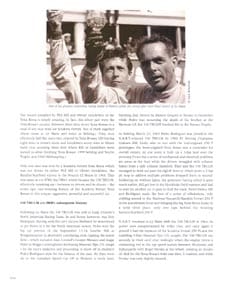
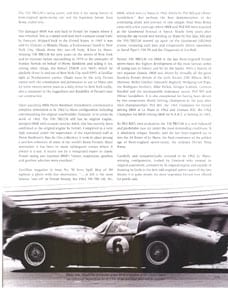
Only one race was won by a Scuderia Ferrari Testa Rossa which was not driven by either Phil Hill or Olivier Gendebien, the Bandini/Scarfiotti victory in the Pescara 12 Hours in 1961. That win came in s/n 0780, the TRI61 which became the 330 TRI/LM, effectively summing up – between its drivers and its
chassis – the entire epic race-winning history of the Scuderia Ferrari Testa Rossas
in this unique, aggressive, powerful and successful car.
330 TRI/LM s/n 0808’s subsequent history
Following Le Mans the 330 TRI/LM was sold to Luigi Chinetti’s North American Racing Team. Its real buyer, however, was Don Rodriguez. Having seen the car’s success firsthand he determined to put Pedro in it for the North American season. Pedro won the big car portion of the September 15-16 Double 500 at Bridgehampton in absolutely convincing style, lapping the entire field – which included Alan Connell’s Cooper Monaco and Augie Pabst in Briggs Cunningham’s bellowing Maserati Tipo 151 coupé – by the race’s midpoint and proceeding to show off in ebullient Pedro Rodriguez style for the balance of the race. He
then went on to the Canadian Sports Car GP at Mosport a week later, finishing 2nd. Driven by Masten Gregory at Nassau in December while Pedro was mourning the death of his brother at the Mexican GP, the 330 TRI/LM finished 4th in the Nassau Trophy.
At Sebring March 23, 1963 Pedro Rodriguez was joined in the N.A.R.T.-entered 330 TRI/LM by 1962 F1 Driving Champion Graham Hill. Easily able to run with the mid-engined 250 P prototypes, the front-engined Testa Rossa was a contender for overall victory. At one point it built up a 3-lap lead over the pursuing P-cars but a series of mechanical and electrical problems ate away at the lead while the drivers struggled with exhaust fumes from a split exhaust manifold. They and the 330 TRI/LM managed to hold out past the eighth hour at which point a 2-lap pit stop to address multiple problems dropped them to second. Soldiering on without lights, the generator having called it quits much earlier, Hill got lost in the Hendricks Field vastness and had to wait for another car to pass to find the track. Nevertheless Hill and Rodriguez made the best of a series of tribulations, only yielding second to the Mairesse/Vaccarelli/Bandini Ferrari 250 P in the penultimate hour and bringing the big Testa Rossa home in a solid third place, only two laps behind the winning Surtees/Scarfiotti 250 P.
N.A.R.T. returned to Le Mans with the 330 TRI/LM in 1963, its power now complemented by wider tires, and once again it proved it had the measure of the Scuderia Ferrari 250 Ps and the rumbling 5-liter Maserati Tipo 151 coupés. The 330 TRI/LM ran securely in third until after midnight when the engine threw a connecting rod in the top speed section between Mulsanne and Indianapolis with Roger Penske at the wheel, creating an instant oil slick for the Testa Rossa’s wide rear tires. It crashed, and while Penske was only slightly injured the same could not be said
for the 330 TRI/LM.
Its racing career, and with it the racing history of front-engined sports-racing cars and the legendary Ferrari Testa Rossa, ended here.
Subsequent History
The damaged 0808 was sent back to Ferrari for repairs where it was rebodied, first as a spider and later with a unique coupé body by Fantuzzi. Shipped back to the United States, in 1965 it was sold by Chinetti to Hisashi Okada, a businessman based in New York City. Okada drove this one-off body, 4-liter Le Mans-winning 330 TRI/LM for nine years on the streets of New York and its environs before succumbing in 1974 to the entreaties of Stanley Nowak on behalf of Pierre Bardinon and selling it for, among other things, the Ferrari 250LM (s/n 5845) which he similarly drove in and out of New York City until 1993. A familiar sight at Northeastern events, Okada must be the only Ferrari owner with the constitution and persistence to use Le Mans cars for some twenty-seven years as a daily driver in New York traffic, also a testament to the ruggedness and durability of Ferrari’s race car construction.
Upon acquiring 0808 Pierre Bardinon immediately commenced a complete restoration to its 1962 Le Mans configuration including commissioning the original
coachbuilder, Fantuzzi, to re-create its work of 1962. Despite the engine failure at Le Mans in 1963, the 330 TRI/LM still has its original engine.
Stamped 0808 with numero interno 46SA, this has recently been confirmed as the original engine by Ferrari. Completed to a very high standard under the
supervision of the experienced staff at Pierre Bardinon’s Mas du Clos collection, it took its place among a peerless collection of some of the world’s
finest Ferraris. Since restoration it has been in many subsequent events where it always is a star. A recent test by a recognized expert in classic Ferrari racing cars reported 0808’s “motor, suspension, gearbox and gearbox selection were excellent.”
Cavallino
magazine in issue No. 50 from April May of ’89 captions a photo with this observation: “… at left is the most famous “one off” in Ferrari history, the 1962 330 TRI LM, No. 0808, which won Le Mans in 1962, driven by Phil Hill and Olivier Gendebien.” But perhaps the best demonstration of the continuing allure and potency of this unique, final Testa Rossa came only a few years ago when 0808 and Phil Hill were reunited at the Goodwood Festival of Speed. Nearly forty years after setting the lap record and winning Le Mans by five laps, Hill and the 330 TRI/LM teamed up again on the Goodwood hillclimb course, trouncing such later and competently driven opposition as David Piper’s 330 P4 and the Chaparrals.
Ferrari 330 TRI/LM s/n 0808 is the last front-engined Ferrari sports-racer, the highest development of the most famous series of racing cars in history and by far the fastest. With a history of two separate chassis, 0808 was driven by virtually all the great Scuderia Ferrari drivers of the early Sixties: Cliff Allison, Willy Mairesse, Richie Ginther, Giancarlo Baghetti, Wolfgang von Trips, the Rodriguez brothers, Mike Parkes, Giorgio Scarlatti, Lorenzo Bandini and the incomparable endurance racers, Phil Hill and Olivier Gendebien. It is also exceptional for having been driven by two consecutive World Driving Champions in the year after their championships: Phil Hill, the 1961 Champion for Ferrari driving 0808 at Le Mans in 1962 and Graham Hill, the 1962 Champion for BRM driving 0808 for N.A.R.T. at Sebring in 1963.
By Phil Hill’s own evaluation the 330 TRI/LM is a well-balanced and predictable race car under the most demanding conditions. It is absolutely unique, historic, and the last front-engined car to win the 24 Hours of Le Mans, the final expression of the golden age of front-engined sports-racers, the ultimate Ferrari Testa Rossa.
Carefully and sympathetically restored to its 1962 Le Mans-winning configuration, bodied by Fantuzzi who created its original coachwork, powered by its original engine and capable of showing its heels to the best mid-engined sports-racers of the late Sixties, it is quite simply the most important Ferrari ever offered for public sale.
Click here to return to the auction catalog descriptions index page.